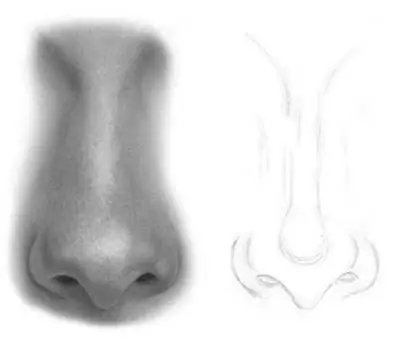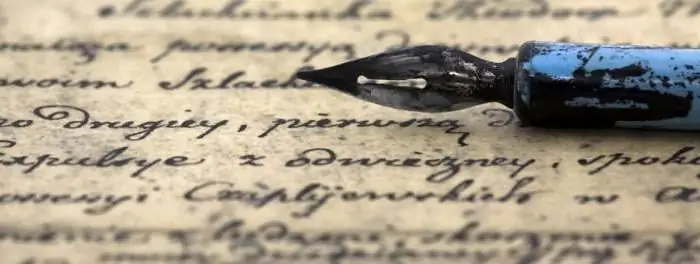2026 Author: Leah Sherlock | [email protected]. Last modified: 2025-01-24 17:46:27
If you decide to master the basic pencil drawing techniques, whether you are an adult or a child, you need to start by depicting simple things and learning the basic rules for working with the material. The main thing is to be consistent, follow all the steps in turn. And also be patient and willing to learn.

Types of pencils
To master the various pencil drawing techniques, you need to figure out which material options are used. Any pencil consists of a base (wooden or plastic for a mechanical one) and a lead, which can be graphite, but not only that.
Ordinary pencils, which are called simple, come in different softness: hard is marked with the English letter H, soft B. The number next to the letter indicates the degree of this indicator, for example, 5B is a very soft lead.
Colored pencils are often used. It is interesting to work with watercolor pencils as an addition to the same paints or as an independent material.

For ease of use in the form of pencils, other artisticmaterials: charcoal, chalk, sanguine, etc.
What you need besides pencils
You can use different techniques for drawing with a simple pencil. In accordance with the selected option, paper and other related materials are purchased. If you will be doing fine line drawing, the sheet should be dense and smooth, and the pencils should be hard or medium. Mistakes are corrected with a soft eraser.
If you draw three-dimensional images with chiaroscuro transmission using hatching, the pencils must be sharply sharpened, and preferably not with a sharpener, but with a knife, so that the free part of the stylus protrudes 1-1.5 cm from the base.

To work by shading graphite, you will need a piece of soft paper, cloth or cotton pad. For this work option, paper with an uneven surface is suitable, for example, even watercolor and soft pencils. Excess graphite is easy to remove with a special soft eraser, similar to plasticine, or bread crumb. As you can see, it is important to decide in advance which method you will do the work in order to properly prepare the materials.
Basics of pencil drawing technique
There are several ways to complete a painting:
- from memory or from imagination;
- from nature (a real object is in front of you);
- from photo or sample (copy method).
In any of these ways, the general sequence of work will be as follows:
- Choose the size of the sheet and its location(vertical or horizontal).
- Apply basic dimensional ratios of objects.
- Draw the outlines of large shapes.
- Paint small details.
- Transmit the volume of objects and chiaroscuro. The lightest areas (highlights) are best left white, and the dark ones should also be done last.
If the selected pencil drawing techniques involve shading or shading the entire sheet, work carefully so as not to overwrite the completed parts of the image with your hand. Put a sheet of paper under your arm or attach the drawing to the easel and try to rely on the drawing not with the entire side of the hand, but only with your finger.
How to draw an outline image
This version of the work is used as an independent method or as a preliminary application of the shapes of objects for the subsequent study of chiaroscuro or painting with paints.
The easiest pencil drawing technique for beginners is to draw an image from a sample over a grid or cells.

Work goes like this:
- Take your favorite photo or picture and draw on it or on film so as not to spoil the source, a grid consisting of square cells. The smaller they are, the more accurate and easier it will be to transfer the image.
- On the prepared sheet of paper, draw the same grid with the same number of cells. If the image is transferred in the same scale, then the size of the squares is taken the same. To enlarge the sample, simply scale the cell size.
- Analyze the contours of objects as they intersect the cells of the grid superimposed on the sample and draw similarly on your blank sheet.
It's even easier to trace the outline of the image through glass that has a light source on the back, but in this case, your sheet and sample base should be fairly thin and translucent.
If you are going to draw professionally, do not use the above options, but work like this:
- Mark the boundaries of the entire composition inside the sheet (left, right, top and bottom).
- Design the main proportional ratios of objects by eye or by making appropriate measurements, for example, with a pencil.
- Draw the details.
If the image is made as a contour for working with paints, shading or hatching, make it only with thin lines. If the work will be linear, it is usually worth highlighting the foreground objects with a softer pencil or a wide line.
How to add volume
Many people start with drawing faces when they decide to master pencil drawing techniques. The portrait, in fact, is one of the most difficult subjects. If you decide to focus on it, please note that each detail is a three-dimensional form, and not a flat one, which looks like in a photograph or picture. Nose, eyes, lips - all have their own shade and black and white detailing. The same goes for any other objects.

There are two ways to transfer volume:
- hatching;
- shading.
In the first case, the strokes are superimposed according to the shape (vertically on a straight surface, arcuately on a complex spherical shape). To convey the effect of dense material, the strokes must be applied close to each other so that the face does not get "grass" or "hair". For beginners, it is difficult to perform accurate hatching, so it is better to use the second method. Shading involves the imposition of tone, followed by rubbing graphite on the sheet within the shape of a particular object or part of it. Black and white transitions are soft, and the image is more realistic, although professionals usually do not use this method.

Watercolor pencil drawing techniques
This type of pencil is very interesting for both beginners and those who already have experience in this field. Watercolor pencils are used in different ways:
- As an independent drawing material.
- To work out the details of a watercolor painting.
- To draw and then blur part of the image.

It is worth remembering that detailing should be carried out after work is completed, so that water does not fall on the traced elements. And if you are going to blur two adjacent objects of different colors, you should first blur both shapes and only after that - the border of contact between the shapes.
As you can see, drawing techniquespencil are as varied as the material itself. If you are a beginner, do the first jobs by copying the patterns over the grid. When you try your hand at line drawing, move on to shading. Hatching and drawing from life is the hardest thing to do.
Recommended:
The best watercolorists in the world: works, drawing techniques, photos

To the proposal to draw something with watercolors, every child and even, perhaps, an adult, will probably not be taken seriously. But how many people know what kind of capricious paint it really is and how laborious it makes the painting process? In this article, you will find out who was not afraid to curb the naughty nature of watercolor
Basic artistic techniques. Artistic techniques in a poem

What are artistic techniques for? First of all, in order for the work to correspond to a certain style, which implies a certain imagery, expressiveness and beauty. In addition, the writer is a master of associations, an artist of the word and a great contemplative. Artistic techniques in poetry and prose make the text deeper
Watercolor drawing - techniques, techniques, features

Surprisingly light, airy watercolors evoke an irresistible desire to take brushes and paints and create a masterpiece. But watercolor painting requires preparation - these paints are not as easy to work with as it might seem at first glance
Learning to draw a graphic portrait with a pencil

Many aspiring artists dream of learning how to draw portraits with a pencil. This is a completely new level in creativity. Having learned to portray a portrait of a person, it will be possible to easily master the watercolor technique, draw with sanguine and charcoal, as well as oil. You need to start by all means with pencil sketches. Confidently manipulating graphic materials, you can achieve an incredible resemblance to nature
How to draw a rose with a pencil: step by step learning

The ability to draw beautifully is not given to everyone. But with the proper desire, you can learn everything. You just need to devote some free time and make some effort. For example, a pencil drawing of a rose. It seems complicated only at first glance. In fact, if you follow the step-by-step instructions, everything is quite simple. Try it yourself

